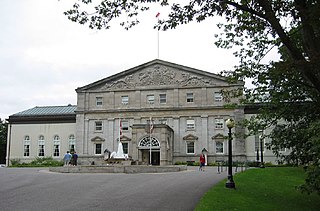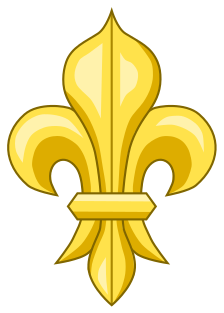
Heraldry is a broad term, encompassing the design, display, and study of armorial bearings, as well as related disciplines, such as vexillology, together with the study of ceremony, rank, and pedigree. Armory, the best-known branch of heraldry, concerns the design and transmission of the heraldic achievement. The achievement, or armorial bearings usually includes a coat of arms on an shield, helmet, and crest, together with any accompanying devices, such as supporters, badges, heraldic banners, and mottoes.

A coat of arms is a heraldic visual design on an escutcheon, surcoat, or tabard. The coat of arms on an escutcheon forms the central element of the full heraldic achievement which in its whole consists of shield, supporters, crest, and motto. A coat of arms is traditionally unique to an individual person, family, state, organization or corporation.

The coat of arms of British Columbia is the heraldic symbol representing the Canadian province of British Columbia. The arms contains symbols reflecting British Columbia's British heritage along with local symbols. At the upper part of the shield is the Union Jack, representing the United Kingdom. The lower portion of the shield features a golden sun setting into the ocean, representing the province's location on the Pacific.

The coat of arms of Manitoba is the heraldic symbol representing the Canadian province of Manitoba. The arms contains symbols reflecting Manitoba's British heritage along with local symbols. At the upper part of the shield is the red cross of St. George, representing England. The lower portion of the shield features a buffalo standing atop a rock on a green background.

The coat of arms of New Zealand is the heraldic symbol representing the South Pacific island country of New Zealand. Its design reflects New Zealand's history as a bicultural nation, with a European female figure on one side and a Māori rangatira (chief) on the other. The symbols on the central shield represent New Zealand's trade, agriculture and industry, and a Crown represents New Zealand's status as a constitutional monarchy.

The Canadian Heraldic Authority is part of the Canadian honours system under the Canadian monarch, whose authority is exercised by the Governor General of Canada. The authority is responsible for the creation and granting of new coats of arms, flags, and badges for Canadian citizens, government agencies, municipal, civic and other corporate bodies. The authority also registers existing armorial bearings granted by other recognized heraldic authorities, approves military badges, flags, and other insignia of the Canadian Forces, and provides information on heraldic practices.

The most basic rule of heraldic design is the rule of tincture: metal should not be put on metal, nor colour on colour. This means that Or and argent may not be placed on each other; nor may any of the colours be placed on another colour. Heraldic furs as well as "proper" are exceptions to the rule of tincture.

Portuguese heraldry encompasses the modern and historic traditions of heraldry in Portugal and the Portuguese Empire. Portuguese heraldry is part of the larger Iberian tradition of heraldry, one of the major schools of heraldic tradition, and grants coats of arms to individuals, cities, Portuguese colonies, and other institutions. Heraldry has been practiced in Portugal at least since the 11th century, however it only became standardized and popularized in the 16th century, during the reign of King Manuel I of Portugal, who created the first heraldic ordinances in the country. Like in other Iberian heraldic traditions, the use of quartering and augmentations of honor is highly representative of Portuguese heraldry, but unlike in any other Iberian traditions, the use of heraldic crests is highly popular.

The coat of arms of Vancouver was granted by the College of Arms on 31 March 1969.
Danish heraldry has its roots in medieval times when coats of arms first appeared in Europe. Danish heraldry is a branch of the German-Nordic heraldic tradition.

The wolf has been widely used in many forms in heraldry during the Middle Ages. Though commonly reviled as a livestock predator and man-eater, the wolf was also considered a noble and courageous animal, and frequently appeared on the Arms and crests of numerous noble families. It typically symbolised the rewards of perseverance in long sieges or hard industry.

German heraldry is the tradition and style of heraldic achievements in Germany and the Holy Roman Empire, including national and civic arms, noble and burgher arms, ecclesiastical heraldry, heraldic displays and heraldic descriptions. German heraldic style is one of the four major broad traditions within European heraldry and stands in contrast to Gallo-British, Latin and Eastern heraldry, and strongly influenced the styles and customs of heraldry in the Nordic countries, which developed comparatively late. Together, German and Nordic heraldry are often referred to as German-Nordic heraldry.

French heraldry is the use of heraldic symbols in France. Although it had a considerable history, existing from the 11th century, such formality has largely died out in France, as far as regulated personal heraldry is concerned. Civic heraldry on the other hand remains a visible part of daily life.

Icelandic heraldry is the study of coats of arms and other insignia used in Iceland. It belongs to the German-Nordic heraldic tradition, as the heraldry of Iceland has been primarily influenced by the heraldic traditions of Norway, Denmark and other Nordic countries. Iceland does not have a strong sense of heraldic tradition, however, because the country lacks a governing body to oversee this. As a result, coats of arms registered as such are virtually nonexistent in modern Iceland. While many municipalities use more or less heraldic logos, there are no heraldic standards to which these must adhere, and they are registered as graphic designs rather than as coats of arms.

The coat of arms of the London Borough of Barnet is the official coat of arms of the London Borough of Barnet. It was granted on 1 January 1965.

The coat of arms of the London Borough of Camden is the official heraldic arms of the London Borough of Camden. The arms were granted on 10 September 1965. The borough was formed by the merger of three former boroughs, the Metropolitan Borough of Hampstead, the Metropolitan Borough of Holborn and the Metropolitan Borough of St. Pancras, and symbols from their old coats of arms were taken over to the new borough arms.

The coat of arms of the London Borough of Hammersmith and Fulham was granted to the then London Borough of Hammersmith on 1 March 1965, but the motto changed languages in 1969. The subsequent change of names to Hammersmith and Fulham on 1 January 1980 did not affect the arms.

The coat of arms of Oxford is the official heraldic arms of Oxford, used by Oxford City Council.





















